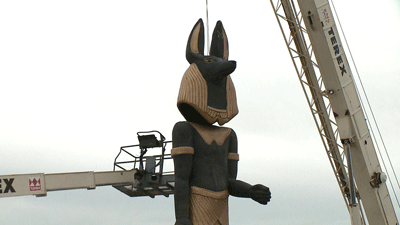If you live in Colorado, or have flown into DIA, you have probably seen the huge blue mustang sculpture that rears its veiny head outside the airport. This single piece of public commissioned art has probably brought about more controversy than any other in Denver. A lot of people hate this sculpture with a passion. I am one of them. It’s ugly, vein-ridden, too masculine, seems to be a nod to the Denver Broncos with its choice of coloring – but it’s not, and has glowing red eyes that just look plain evil. There is even a Facebook page dedicated to hating the Mustang and rallying for its removal. The horse’s nicknames include ‘Satan’s Steed’, ‘Bluecifier’, and ‘Blue Devil Horse’. Also – it is Not a myth that part of the sculpture fell onto the artist in the final stages – and killed him. Seems like an urban legend, but it’s not. So this is what our visitors see when they first get to our City:

“Welcome to Denver. Our evil blue horse just put a hex on you.”
I have learned that publicly commissioned art pieces must stay in place for at least 5 years. I’m not sure after that, but I think it’s probably a pretty big ordeal to have them removed due to public outcry. Now, of course art is in the eye of beholder and one person can see something totally different than another when viewing it. And one person can be offended by a piece, while another is inspired. Take for instance, a sculpture of a man and woman fused in mid-dance that was placed inside a roundabout in a Denver suburb. The woman’s breasts are bared, in rough-hewn bronze, and because the sculpture is in an area where lots of children are, many people want it taken down. We can’t expect every complaint about an art piece to lead to its removal, but at what point is the public outcry enough? When does it lead to a vote?

Now DIA has another sculpture that is raising eyebrows. This one is Anubis – the Egyptian god of the underworld. But people are incorrectly naming it the God of the Dead, and claiming it’s morbid to have a statue representing death right outside the airport, making friends with Bluecifier and all. We know that the Egyptians put a lot of stock in the afterlife. You could say they almost took it more seriously than life itself. So Anubis does not really represent death – but the wonderful world awaiting on the other side. And he’s there to help you to it. But people shouldn’t get too upset: this statue is only temporary. It is there to promote the upcoming King Tut exhibit at the Denver Art Museum. I have always been fascinated by Egyptian life and mythology, so I am anxious to see the statue, and even more anxious to see the exhibit. So I don’t mind Anubis hanging out at DIA. But if given the opportunity to vote on the removal of Satan’s Steed, I definitely would voice my opinion. But that’s all it is – an opinion. So can you really remove art that was specifically chosen, and worked very hard on – just based on people’s perceptions? The artist of the Mustang said the piece represented “the wild spirit of the plains”. But if the majority of others do not see it that way, when are they eventually heard?
